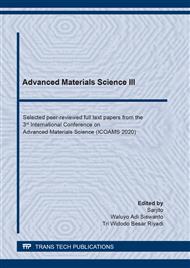[1]
L. R. V.-V. and F. J. García-Orozco, An overview of asphalt pavement design for streets and roads, Rev. Fac. Ing. Univ. Antioquia, (2020).
Google Scholar
[2]
J. G. Speight, Asphalt Paving," J. G. B. T.-A. M. S. and T. Speight, Ed. Boston: Butterworth-Heinemann, 2016, p.409–435.
Google Scholar
[3]
M. English and L. Latin, Asphalt Binder / Cement, (2019).
Google Scholar
[4]
E. Softić, V. Radičević, M. Subotić, Ž. Stević, Z. Talić, and D. Pamučar, Sustainability of the optimum pavement model of reclaimed asphalt from a used pavement structure, Sustain., 12 (2020) 1–21.
DOI: 10.3390/su12051912
Google Scholar
[5]
A. Das, Structural design of asphalt pavements: principles and practices in various design guidelines, Transp. Dev. Econ., 1 (2015) 25–32.
DOI: 10.1007/s40890-015-0004-3
Google Scholar
[6]
R. N. H. John Read, David Whiteoak, The shell bitumen handbook, the fifth. London, UK, (2003).
Google Scholar
[7]
J. Crucho et al., Distribution of the temperature field in a pavement structure, Constr. Build. Mater., 23 (2016), 409–435.
Google Scholar
[8]
J. Crucho, L. Picado-Santos, J. Neves, and S. Capitão, A review of nanomaterials' effect on mechanical performance and aging of asphalt mixtures, 9, (2019).
DOI: 10.3390/app9183657
Google Scholar
[9]
J. Yang and S. Tighe, A review of advances of nanotechnology in asphalt mixtures, Procedia - Soc. Behav. Sci., 96 (2013) 1269–1276.
DOI: 10.1016/j.sbspro.2013.08.144
Google Scholar
[10]
S. Chebil, A. Chaala, and C. Roy, Use of softwood bark charcoal as a modifier for road bitumen, Fuel, 79 (2000) 671–683.
DOI: 10.1016/s0016-2361(99)00196-9
Google Scholar
[11]
N. S. Mashaan, A. Rezagholilou, and H. Nikraz, Waste plastic as additive in asphalt pavement reinforcement: a review," in AAPA International Flexible Pavements Conference, Sydney, New South Wales, Australia, (2019).
Google Scholar
[12]
W. S. Mogawer, A. J. Austerman, and R. Bonaquist, Evaluating effects of warm-mix asphalt technology additive dosages on workability and durability of asphalt mixtures containing recycled asphalt pavement, in Transportation Research Board 88th Annual Meeting, (2009).
DOI: 10.3141/2208-03
Google Scholar
[13]
M. Tao and R. B. Mallick, Effects of warm-mix asphalt additives on workability and mechanical properties of reclaimed asphalt pavement material, Transp. Res. Rec., 2126 (2019), 151–160.
DOI: 10.3141/2126-18
Google Scholar
[14]
N. S. Mashaan, A. L. I. Rezagholilou, and H. Nikraz, A review on using waste polymer as additive in asphalt mixture," in International Journal of Advances in Science, Engineering and Technology, 7 (2019), 58–60.
Google Scholar
[15]
J. Jeevanandam, A. Barhoum, Y. S. Chan, A. Dufresne, and M. K. Danquah, Review on nanoparticles and nanostructured materials: History, sources, toxicity and regulations, Beilstein J. Nanotechnol., 9 (2018) 1050–1074.
DOI: 10.3762/bjnano.9.98
Google Scholar
[16]
V. C. Papadimitropoulos, S. Karatzas, and A. P. Chassiakos, Applications of nanomaterials in pavement engineering: a review, Tenth Int. Conf. Constr, 21 (2018).
Google Scholar
[17]
M. E. Abdullah et al., A review on the exploration of nanomaterials application in pavement engineering, J. Teknol., 73 (2015) 69–76.
Google Scholar
[18]
H. Taherkhani and S. Afroozi, The properties of nanosilica-modified asphalt cement, Pet. Sci. Technol., 34 (2016) 1381–1386.
DOI: 10.1080/10916466.2016.1205604
Google Scholar
[19]
H. Ziari, A. Moniri, and N. Norouzi, The effect of nanoclay as bitumen modifier on rutting performance of asphalt mixtures containing high content of rejuvenated reclaimed asphalt pavement, Pet. Sci. Technol., 37 (2019) 1946–(1951).
DOI: 10.1080/10916466.2018.1471489
Google Scholar
[20]
Z. Naukowe, P. Śląskiej, and S. Transport, Detection on cracks in asphalt pabement during road inspection processes, Sci. J. Silesian Univ. Technol. Ser. Transp., 94 (2017).
Google Scholar
[21]
S. A. M. Hesp et al., Asphalt pavement cracking: analysis of extraordinary life cycle variability in eastern and northeastern Ontario, Int. J. Pavement Eng., 10 (2019) 209–227.
DOI: 10.1080/10298430802343169
Google Scholar
[22]
H. Yao et al., Performance of asphalt binder blended with non-modified and polymer-modified nanoclay, Constr. Build. Mater., 35 (2012), 159–170.
DOI: 10.1016/j.conbuildmat.2012.02.056
Google Scholar
[23]
Y. Hui et al., Rheological properties and chemical bonding of asphalt modified with nanosilica, J. Mater. Civ. Eng., 25 (2013) 1619–1630.
Google Scholar
[24]
Z. You et al., Nanoclay-modified asphalt materials: preparation and characterization, Constr. Build. Mater., 25 (2011), 1072–1078.
Google Scholar
[25]
H. Yao and Z. You, Effectiveness of micro and nanomaterials in asphalt mixtures through dynamic modulus and rutting tests, J. Nanomater., (2016).
DOI: 10.1155/2016/2645250
Google Scholar
[26]
H. Ezzat, S. El-Badawy, A. Gabr, E. S. I. Zaki, and T. Breakah, Evaluation of asphalt binders modified with nanoclay and nanosilica, Procedia Eng., 143 (2016) 1260–1267.
DOI: 10.1016/j.proeng.2016.06.119
Google Scholar


